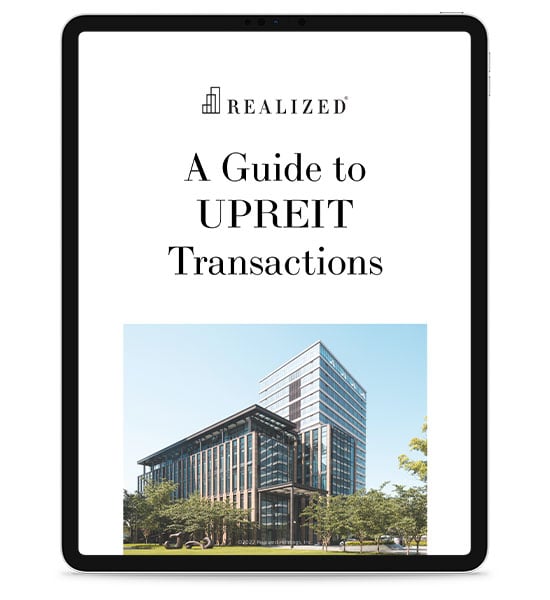
Liquidity and tax efficiency are among the most common concerns among clients with investment real estate. For advisors working with property-heavy portfolios, a challenge is helping clients transition out of illiquid holdings in a way that may help reduce immediate tax consequences. One approach available in certain cases is the DST-to-UPREIT strategy, which may offer a tax-deferred method of accessing REIT-backed equity exposure.
Advisors should know how DST UPREITs work and where they fit into broader investment property wealth management (IPWM) conversations.
What Is a DST UPREIT?
A DST (Delaware Statutory Trust) is a vehicle that allows investors to own fractional interests in institutional-quality real estate while potentially preserving for 1031 exchanges. An UPREIT, short for “Umbrella Partnership Real Estate Investment Trust,” is a structure in which real estate may be contributed to an operating partnership of a REIT in exchange for partnership units, which can later be converted to REIT shares under certain conditions..
In some cases, DSTs may be structured to allow for a contribution of assets to an UPREIT after a hold period. This approach may offer new planning opportunities for advisors managing high-net-worth portfolios with embedded real estate gains, while helping clients preserve capital, generate income, and maintain flexibility.
Why Consider a DST-to-UPREIT Strategy?
For clients nearing the end of a DST’s hold period or those evaluating options for long-term passive real estate exposure with potential liquidity—the DST-to-UPREIT exchange may be a next step worth considering. Here are several factors that could support its use in appropriate circumstances:
- Potential for Continued Tax Deferral: The initial exchange into the DST may have deferred capital gains under Section 1031. In certain cases, a properly structured UPREIT transaction continues that deferral by converting the DST interest into OP (Operating Partnership) units instead of immediately realizing a gain.
- Path to Liquidity: Over time, OP units may be eligible for conversion into publicly traded REIT shares. Subject to applicable terms and holding requirements, these shares can be sold incrementally, potentially offering increased liquidity depending on market conditions.
- Portfolio Diversification: The REIT may hold more properties across sectors and geographies than the original DST, exposing investors to a more diversified real estate portfolio. Diversification benefits are not guaranteed and depend on the REIT's specific holdings.
- Estate Planning Considerations: Upon death, the stepped-up basis applied to OP units or REIT shares could reduce or eliminate the original deferred tax liability, allowing heirs to inherit assets with minimal tax exposure.
Risks and Considerations
DST-to-UPREIT strategies involve important trade-offs that may not suit every investor. Key considerations include:
- Limited Liquidity: OP units are generally illiquid and may require a holding period before conversion to REIT shares, subject to sponsor terms and market conditions.
- Tax Complexity: Continued deferral of capital gains is not automatic. Improper structuring may result in a taxable event. Tax outcomes vary by individual and should be reviewed with a qualified advisor.
- Market and Sponsor Risk: REIT shares are subject to market volatility. Results depend on the REIT’s performance, management, and conversion terms.
- Loss of Control: Investors relinquish direct control over real estate assets and decisions.
- Changing Tax Laws: Estate-related benefits like the step-up in basis rely on current tax laws, which may change.
When Might This Strategy Be Appropriate?
Advisors should consider a DST to UPREIT transition for clients who:
- Are you looking to wind down active or semi-active real estate positions
- Prefer to convert their holdings into liquid, tradable securities over time
- Are nearing or in retirement and value flexibility and income stability
- Have maxed out deferral strategies and are evaluating long-term estate planning
Working closely with tax professionals and qualified sponsors is essential to ensure proper structuring and compliance with IRS guidelines. Advisors should also vet the REIT’s performance, management, and conversion terms to match client goals and timelines.
Final Thoughts
For certain investors, DST-to-UPREIT strategies may offer a way to transition from tax-deferred real estate investments to a structure that provides broader portfolio exposure and potential liquidity. When properly structured and reviewed in the context of each client’s financial and tax situation, this approach may support long-term planning goals.
As IPWM strategies evolve, DST UPREITs are becoming an increasingly relevant part of the conversation.
The tax and estate planning information offered by the advisor is general in nature. It is provided for informational purposes only and should not be construed as legal or tax advice. Always consult an attorney or tax professional regarding your specific legal or tax situation.
Article written by: Story Amplify. Story Amplify is a marketing agency that offers services such as copywriting across industries, including financial services, real estate investment services, and miscellaneous small businesses.
https://www.inland-investments.com/education/1031-exchange-dsts



